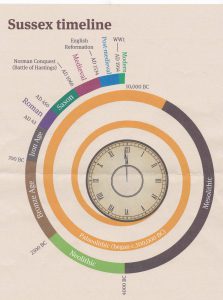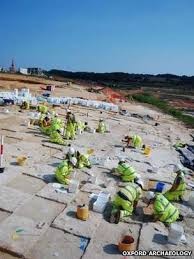Casper Johnson, County Archaeologist, generated growing excitement at Rye Museum on Tuesday evening, June 9, as he revealed in an illustrated talk some of the archaeological discoveries made along a 5.6 km length of the new Bexhill-Hastings link road over the past 18 months. The project – to record and preserve the archaeology affected by the road scheme – is manned by a 45-strong team of Oxford Archaeology specialists in a range of scientific fields and has attracted international attention, because of its unusually wide scope, location in a changing landscape, use of the latest technology to probe with unprecedented precision – and because significant gaps in our understanding of the prehistory of our area are being filled in.
Before we continue, look at the time spiral below, created especially for schools to help boys and girls begin to understand how truly vast is Time. It shows archaeological time periods all the way from Palaeolithic (500,000 to 100,000 years ago) to the tiny green knob at the top which represents the “Modern” period – since the first world war. The findings of the archaeologists working along the route of the Bexhill-Hastings link road come from virtually every period of prehistory and subsequent times, but those from the Stone Age (Palaeolithic, Mesolithic, Neolithic), Bronze Age and Iron Age are of special interest.

Evidence from multiple adjacent excavation sites and the excellent state of preservation (especially in wet river bottoms of the valleys), is allowing the archaeologists to piece together a clearer picture of the landscape in the prehistoric period, where hunter-gatherers were camping, hunting, fishing and making things and having to adapt to changing climate, sea levels and ecology. Everything is being meticulously recorded and analysed, some preserved in situ, some excavated, and discoveries will continue to be made public – an opportunity to understand more about the transition from hunter-gatherer life styles to agriculture and the extent to which different ways of living overlapped.
Johnson presented many examples of findings and what they can tell us. Here are two of them which tell us that manufacturing skills are much older than you might think in Britain.
Firstly, the teams have found over 500,000 flint pieces from 300 sites – many hundreds of pieces per square metre – dating from Upper Palaeolithic, Mesolithic, Neolithic and Bronze ages. The Oxford Archaeology photo below shows workers on one of the sites.
The flints are of different sizes and types and made for specific uses, for example harpoons and arrows for killing different types of prey. Finding hundreds of small, precisely cut “microliths” of just one type in a particular spot is evidence of the skill and organization of the producers. Click here for a page which includes a photo of Early Bronze Age barbed-and-tanged arrowheads.

There is even evidence at one site to suggest it was used repeatedly over 4000 years as a prehistoric school or training centre for teaching the craft!
The flint discoveries make this the most important archaeological excavation of its type ever undertaken in the UK.
Secondly, there appears to have been at least one Bloomery for processing iron ore; the site is now a farm on the outskirts of St Leonards. Most readers will know of Roman ironworks in this area, but if an earlier date is confirmed for this Romano-British ironworking site, with its 17 furnaces and a smithy and evidence for every stage of the process, it will be a very important mine of information indeed.
Another task for Oxford Archaeology is to determine whether a one ring ditch now excavated, started life as a form of henge in the Neolithic period and then developed into a round barrow in the Bronze Age. Recent archaeological projects in the Hastings area have revealed the existence of at least seven circular ditched monuments of prehistoric and probable Bronze Age date.
Other interesting finds include what is thought to be a Bronze Age field system and track-way, Samian ware from southern Gaul complete with the maker’s stamp and high quality amphorae and cups produced in France about AD 150; the import trade in Britain has a very long history! We also heard about evidence that dormice were nibbling hazel nuts along today’s new route 10,000 years ago, and how worms can complicate dating because they cause items to drop down a level or two.
Among the greatest beneficiaries of the archaeological work will be present and future generations of local schoolchildren, as Prehistory is now on the National Curriculum. East Sussex children can now take pride in knowing they live in an area where humans have been settling for thousands of years and have left behind proof of their activities while here. One member of the audience, who had supported protesters of the link road, was quick to tell our speaker that she’d been completely converted during the evening, because of all the worthwhile educational benefits accruing.
There have been roles for local groups too, such as the Hastings Area Archaeological Group. Volunteers with metal detectors helped in pinpointing the most promising sites to excavate. They turned up 171 finds in five days.
The findings will keep historians and archaeologists busy for years, but you can get some idea of the project and its treasures by visiting the Bexhill Museum, where an exhibition shows objects dating from just after the last Ice Age up to the Saxon period. And you will find research updates on the East Sussex County Council website.
Photos: Oxford Archaeology



